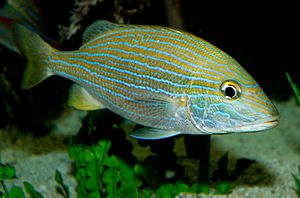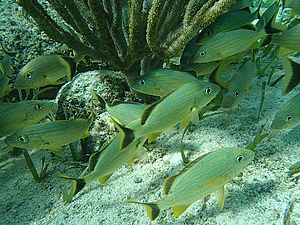Blue striped grunt facts for kids
Quick facts for kids Blue striped grunt |
|
|---|---|
 |
|
| Scientific classification | |
| Genus: |
Haemulon
|
| Species: |
sciurus
|
| Synonyms | |
|
|
The blue striped grunt (Haemulon sciurus) is a cool fish that lives in the warm waters of the western Atlantic Ocean. You might also hear it called the bluestriped grunt or red mouth grunt. It gets its name from the bright blue stripes on its body and the grunting sounds it makes! It makes these sounds by grinding its teeth, and a special part of its body, called a swim bladder, helps make the sound louder.
Contents
History of the Blue Striped Grunt
The blue striped grunt was first officially described in 1803 by an English scientist named George Shaw. He gave it the scientific name Sparus sciurus. The word sciurus means "squirrel," and people sometimes called this fish a "squirrelfish" because of the grunting noises it makes. Its first known home was recorded as the Antilles.
What Does a Blue Striped Grunt Look Like?
Blue striped grunts usually grow to be about 20 to 25 centimeters (8 to 10 inches) long. The longest one ever found was 46 centimeters (18 inches) long! These fish can live for up to 12 years and can weigh up to 750 grams.
Their heads and bodies are bright yellow with many thin, horizontal blue stripes. A special stripe under their eye has a cool arched shape. They have one yellow dorsal fin (on their back) with 12 strong spines and 16 or 17 soft rays. Their anal fin (on their underside) is a dusky yellow, with three spines and nine soft rays. The soft parts of their dorsal and tail fins are dark, almost black. The scales above their side line are larger, and the scales below are slanted.
Where Do Blue Striped Grunts Live?
You can find blue striped grunts in places like mangroves, seagrass beds, steep drop-offs, and coral reefs. They live in waters up to 30 meters (about 100 feet) deep. Their home range stretches across the Western Atlantic, including Florida, the Gulf of Mexico, and the Caribbean Sea, all the way down to Brazil.
How Do Blue Striped Grunts Behave?

These fish often travel in large groups called schools. They sometimes swim with smaller French grunts, which are close relatives. A school can have as many as 1,000 grunts! These schools usually swim near coral reefs.
Blue striped grunts mostly eat shrimp. They might also munch on annelids (like worms), bivalves (like clams), and other crustaceans (like crabs). Bigger fish, such as sharks, are some of the main predators that hunt grunts.
Blue Striped Grunts and Humans
Blue striped grunts are edible, and many people think they taste good, just like other grunt species. However, they are one of the smaller types of grunts. Sometimes, eating this fish can cause an illness called ciguatera poisoning, which means it's not always safe to eat. Because they are small and can sometimes cause this illness, they are not a major fish for commercial fishing. When they are caught, they are usually sold fresh. People who fish for fun or for business often use these grunts as bait for bigger fish.
Blue striped grunts are also popular in public aquariums. Their beautiful colors make them a very attractive fish to display!
See also
 In Spanish: Haemulon sciurus para niños
In Spanish: Haemulon sciurus para niños

